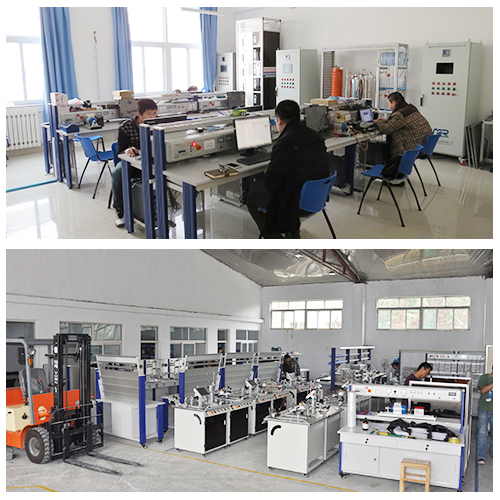MR1003R Mobile Didactic Bench On Wind-Solar Hybrid Renewable Training Equipment Teaching Equipment
1. Equipment introduction
1.1 Overview
Mobile teaching platform specially designed for studying photovoltaic systems and batteries. This teaching bench combines modern mobile equipment with efficient teaching functions to provide students and researchers with a flexible, practical and easy-to-operate platform to conduct experiments and research on photovoltaic systems and cells.
1.2 Features
(1) Portability: The mobile teaching platform is designed to be lightweight and compact, and can be easily moved between different locations. This allows students and researchers to conduct experiments in different environments such as laboratories, classrooms, and in the field.
(2) Versatility: Mobile teaching platforms are usually equipped with a variety of experimental equipment, such as programmable DC power supplies, batteries, multimeters, etc., which can be used to conduct experiments on various photovoltaic systems and batteries.
(3) Ease of use: Mobile teaching benches usually have user-friendly interfaces and operating guides, allowing students and researchers to conduct experiments conveniently even without professional knowledge.
(4) Data recording and analysis: Mobile teaching platforms are usually equipped with data recording and analysis functions, which can record and analyze experimental data in real time, helping students and researchers better understand the working principles of photovoltaic systems and batteries.
(5) Safety: Mobile teaching platforms usually have safety functions such as overload protection and short-circuit protection to ensure the safe conduct of experiments.
2.Technical parameters
Input power: three-phase five-wire 380V, 50Hz
Size: 1310mm*730mm*2050mm
Weight: 200KG

Ambient temperature: -10℃~+40℃
Relative humidity: <85% (25℃)
3. Components list and detailed introduction
3.1 Main part
No Name
1 Aluminum frame
2 Three-phase multi-function meter module
3 Power multimeter module
4 Power switch module
5 Small wind turbine switching power supply module
6 Three-phase power switch module
7 communication panel
8 Light panel 230V module
9 Hybrid inverter module
10 computer module
11 Small wind turbine charge controller 12V
12 Three-phase variable ohmic load 1000w module
13 Programmable DC power supply
14 Protected power distribution module for workstations
15 battery module
16 Dynamic servo machine testing system for 0.3KW machines
17 Small wind turbine 370W with demo mast
3.2 Accessories
No Name Qty
1 digital multimeter 2
2 4mm safety connection cable double color 0.25 meters 2.5 mm² 4
3 4mm safety connection cable red 0.25 meters 2.5 mm² 2
4 4mm safety connection cable green 0.25 meters 2.5 mm² 2
5 4mm safety connection cable yellow 0.25 meters 2.5 mm² 2
6 4mm safety connection cable blue 0.25 meters 2.5 mm² 2
7 4mm safety connection cable double color 1 meter 2.5 mm² 1
8 4mm safety connection cable red 1 meter 2.5 mm² 2

9 4mm safety connection cable green 1 meter 2.5 mm² 2
10 4mm safety connection cable blue 1 meter 2.5 mm² 2
11 4mm safety connection cable black 1.5 meters 2.5 mm² 5
12 4mm safety connection cable red 1.5 meters 2.5 mm² 5
13 4mm safety connection cable green 1.5 meters 2.5 mm² 4
14 4mm safety connection cable yellow 1.5 meters 2.5 mm² 4
15 4mm safety connection cable blue 1.5 meters 2.5 mm² 3
16 Network cable 1 meter Category 5 yellow 1
17 Network cable 2 meters Category 5 yellow 2
18 USB 2.0 Ethernet adapter 1
19 5-port Ethernet switch 1
20 European style plug strip 6 positions with switch 1
21 U-shaped connector 4mm safety connection cable black 10
22 U-shaped connector 4mm safety connection cable red 5
23 RJ12 line 6P4C 1.5 meters 4
24 European plug 1
25 USB cable 1
26 U disk 1
27 pc 1
4. Experiment list
Experiment 1 Installation of photovoltaic hybrid system with small wind turbine experiment
Experiment 2 Parameter experiment of charge controller
Experiment 3 Experiment 3 Load current test experiment
Experiment 4: Energy flow experiment through solar path simulation and wind profile simulation
Experiment 5 Matlab software testing experiment

